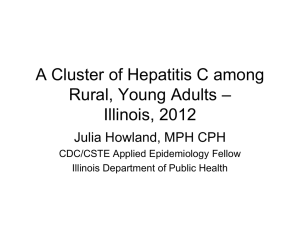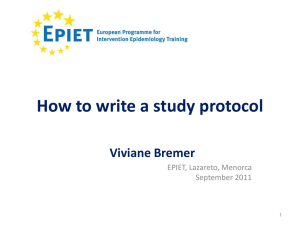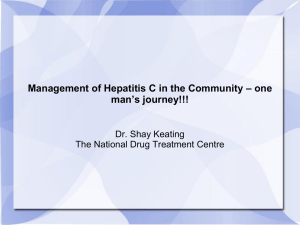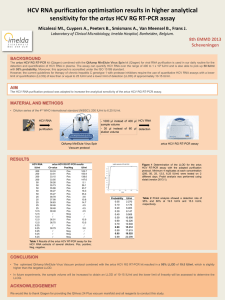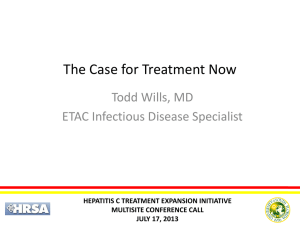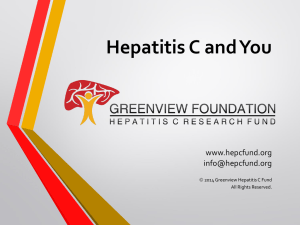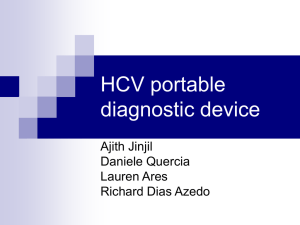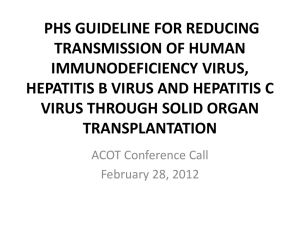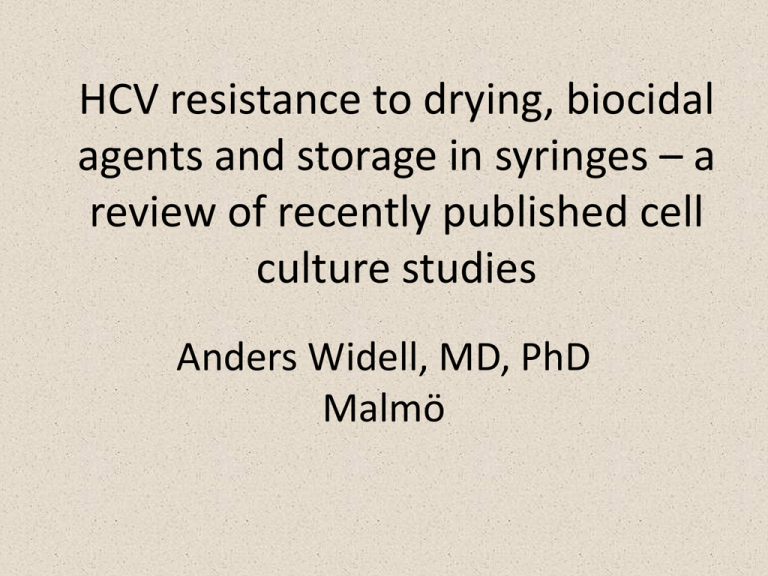
HCV resistance to drying, biocidal
agents and storage in syringes – a
review of recently published cell
culture studies
Anders Widell, MD, PhD
Malmö
Hepatitis C virus
• An enveloped RNA virus, transmitted via blood
and secretions, often leading to chronic
hepatitis C and late complications
• Unsafe injection practices, reused needles
• Nosocomial HCV infections frequent also in
high tech settings
• Multidose vials, back flow in i-v lines,
contaminated gloves, unexpected situations
• Contaminated surfaces (Alfurey el al, 2000)
PCR study by Alfurayh (Am J Nephrol
2000: 20; 103)
• Saudi dialysis ward - 50% of patients already had HCV
• General precautions; new gloves for each patient;
special machines and staff for HCV positive patients
• Handwash (1l sterile H2O) by order of research nurse
• Wash fluid filtered (0.22 um), HCV PCR on retenate
• 24% (19/80) of nurses treating HCV pos patients
were HCV RNA positive in wash fluid
• 8% (8/100) of nurses treating HCV neg patients had
HCV RNA positive in wash fluid (p less than 0.003)
• 3.3% (2/60) of wash fluid before dialysis HCV RNA +
Until now no simple virus viability marker
for hepatitis C virus
• HBV can not be grown in vitro, HCV with difficulty
• Chimps, the only non human host, are unsuitable
• Surrogate viruses for HBV: Duck hepatitis B virus,
Woodchuck Hepatitis Virus
• For HCV: Flaviviridae (e.g. Bovine Viral Diarrhea
Virus, GB virus-B)
• Recently it has become possible to grow certain lab
JFH-1 derived recombinant strains of HCV in cell
culture
Luciferase HCV cell culture system
• Recombinant HCV Jc1 lab strain 2a/2a can grow
in Huh 7.5 hepatoma cell line
• Plasmid engineered to contain full length cDNA
for this virus, preceded by strong ECMV IRES
(internal ribosomal entry site)
• This in turn preceded by firefly luciferase under
HCV IRES.
• Huh 7.5 cells are electroporated with RNA
transcripts – produces infectious HCV particles
that upon growth express luciferase
Subsequent infectivity assays
• The luciferase activity upon cell lysis can be
measured directly after e.g. 48-72 hours
– Measured in Relative Light (or Luciferase) Units
(RLU/well)
• The Tissue Culture Infectious Dose 50%
(TCID50) can be measured after transfer in
serial dilutions to uninfected cells, growth and
luciferase reading at end-point (Y/N) –
classical infectivity assay
– TCID50 expressed in log scale
Figure 1. Linear dynamic range
of microculture assay. Aliquots
(100 mL) of serial 1:2 dilutions
of stock virus were used to
infect Huh 7.5 cells. After 3
days of incubation, the culture
supernatant was harvested and
the concentration of virus
determined as a function of
relative luciferase activity (RLU)
plotted as a function of the
concentration of input virus
(median tissue culture infective
dose [TCID50]/mL) on a logarithmic scale. The experiment
was performed on 2 separate
time points in triplicate, and the
data were combined for
analysis
Paintsil et al JID 2010
So which parameters have been
assessed?
• Ciesek JID 2010
• Doerbacker JID 2011
Figure 1.Stability of hepatitis C
virus (HCV) at different
temperatures.
A, Luc-Jc1 virus was incubated at
the 3 temperatures and time
intervals as a test virus suspension.
Infectivity was determined by
inoculation of naive Huh7.5 cells
for 4 h. HCV infection was
quantified by measuring HCV
reporter activity 48 h later. RLU,
relative light units; t1/2, half-life.
B, Jc1 wild-type virus was stored
for up to 252 days at 4oC. At the
indicated time points, virus aliquots
were tested for infectivity by a
limiting dilution assay; TCID50, 50%
tissue culture infective dose
Ciesek et al JID 2010
Figure 2.Importance of serum and
different surfaces for hepatitis C virus
(HCV) stability.
A, Luc-Jc1 virus was stored in the
presence of human serum or medium
at room temperature at the indicated
time points. Infectivity was
determined by inoculation of naive
Huh7.5 for 4 h. HCV infection was
quantified by measuring HCV reporter
activity 48 h later.
B, HCV reporter virus Luc-Jc1 was
incubated as a viral suspension on
plastic, steel, or gloves at room
temperature for the indicated time
points. HCV reporter infectivity was
determined by inoculation of naive
Huh7.5 cells.
Ciesek et al JID 2010
Figure 3. Effect of heat and different pH values
on hepatitis C virus (HCV) stability.
A, Luc-Jc1 virus was incubated at the indicated
temperatures and time intervals as a viral
suspension with a volume of 300 mL in a
heating block. Infectivity was determined by
inoculation of naive Huh7.5 cells for 4 h
B, Luc-Jc1 reporter viruses were treated with
different pH values after determination of HCV
infectivity by inoculation of naive Huh7.5 cells
and detection of luciferase
activity.
Ciesek et al JID 2010
Ciesek et al JID 2010
Figure 4. Correlation of viral infectivity with
hepatitis C virus (HCV) RNA copy numbers.
A, Wild-type Jc1 virus was stored for up 35 days
at room temperature. Every 7 days viral titers
were determined by a limiting dilution assay;
TCID50
B, HCV RNA of the respective viral supernatant
was isolated and quantified by RT PCR.
C, The HCV RNA isolated from days 0 and 21
was used for reelectroporation of Huh7.5 cells.
After 48 h, cells were fixed and stained by
immunofluorescence for the HCV
protein NS5A
Figure 5. Inactivation of hepatitis C virus (HCV) vs bovine viral diarrhea virus (BVDV) by different
kinds of alcohols (ethanol, 1-propanol, and 2-propanol) A. Test for efficacy in inactivating HCV.
The biocide concentrations ranged from 5% to 40%, with exposure times of 1 or 5 min. For this
inactivation assay, 1 part virus is mixed with 9 parts alcohol. Residual infectivity are displayed as
50% tissue culture infective dose (TCID50) values. B, Efficacy of ethanol, 1-propanol and 2propanol against BVDV was addressed as above.
Ciesek et al JID 2010
Hand scrubs products:
A (based on povidoneiodine),
B (based on chlorhexidine digluconate),
C (based on triclosan).
Hand rub products:
D (55 g of ethanol and 10 g of 1-propanol),
E (>90 g of ethanol),
F (55 g of ethanol and 10 g of1-propanol),
G (45 g of ethanol and 18 g of1-propanol).
Figure 6. Effect of commercial hand
antiseptics against hepatitis HCV.
A, Seven commercial hand
antiseptics ( A–G) were tested in a
quantitative suspension assay for
their efficacy in inactivating HCV.
Incubation times of 30 s were
used, with different products at 90%
concentrations.
B, Commercial disinfectants ( A–G)
were instead diluted 1:10 with
water and evaluated in a
quantitative suspension assay, as
described for A.
Ciesek et al JID 2010
Moving to virus on surfaces
Experimental setup for hepatitis C virus (HCV) carrier assay.
Doerrbecker J et al. J Infect Dis. 2011;204:1830-1838
© The Author 2011. Published by Oxford University Press on behalf of the Infectious Diseases
Society of America. All rights reserved. For Permissions, please e-mail:
journals.permissions@oup.com
Effect of different kinds of alcohol against hepatitis C virus (HCV).
Doerrbecker J et al. J Infect
Dis. 2011;204:1830-1838
© The Author 2011. Published by Oxford University Press on behalf of the Infectious Diseases
Society of America. All rights reserved. For Permissions, please e-mail:
journals.permissions@oup.com
Figure 3. Effect of commercial
surface disinfectants against
HCV
A, Two alcohol-based commercial
surface disinfectants (products A
and B) were tested in a carrier
assay for their virucidal efficacy
against HCV. Concentrations of
10%, 50%, and 100% were used
with an exposure time of 5
minutes. Residual infectivity was
expressd as TCID 50
B, Four commercial surface
disinfectants (products C–F) were
tested in a carrier assay for their
virucidal efficacy against HCV as
described in panel (A) with
concentrations of 0.025%, 0.25%,
and 0.5%.
Dörrbecker et al JID 2011
Figure 4. Stability of dried
hepatitis C virus.
A, Jc1 in the presence or
absence of human serum was
dried on a carrier and incubated
for several days at room
temperature at indicated time
points. Infectivity was determined
by a limiting dilution assay
(TCID50).
B, Different biocides at indicated
concentrations and exposure time
of 5 minutes were tested in a
carrier assay for their efficacy in
inactivating HCV in the presence
or absence of human serum.
Residual infectivity was
determined by a limiting dilution
assay as TCID50 values
. Dörrbecker et al JID 2011
Figure 5. Hepatitis C virus stability on equipment for
heating drugs into solution.
A, Design, Viral suspensions of 800 uL were used as
inoculum of a spoon as cooker heated with a tea candle.
Temperatures of the suspensions were measured at
specific time intervals, and at given temperatures 70 uL
of the viral suspension was sampled. Infectivity was
determined by infection of naive Huh7.5 cells following
luciferase reporter assay.
B, Results Luc-Jc1 reporter virus was incubated as
described and the values of 9 independent
measurement series are shown.
C, Luc-Jc1 reporter virus was incubated on a spoon as
described as above and water and serum were added in
a dilution of 1:8 with the virus suspension before
temperatures were increased and values of at least 2
independent measurement series are shown.
Dörrbecker et al JID 2011
And what about HCV stability in syringes ?
Figure 2. Hepatitis C virus decay rate
at room temperature. Aliquots (100
mL) of the virus were stored 0–96 h at
room temperature. Aliquots were
removed from room temperature
every 6 h or less and stored at -80C.
The stored aliquots were thawed and
used to infect Huh-7.5 cells. The
relative infectivity was determined by
measuring the relative luciferase units
(RLU) after 3 days of infection. Each
value is the mean of 2 independent
experiments.
Paintsil et al JID 2010
Figure 3. Survival of hepatitis C virus
(HCV) in low void volume
(“dödvolym”) insulin syringes.
Syringes were loaded with HCVspiked blood to simulate “booting.”
Syringes were stored at 4C, 22C,
and 37C for up to 14 days before
contents were flushed to infect Huh7.5 cells. HCV survival, a function of
infectivity, was determined
RLU after 3 days of culture. There
were 15 syringes at each time point
in each experiment.
A, The percentage of HCV positive
syringes.
B, HCV infectivity per positive low
void volume syringe. Each value is
the mean standard error of mean
from at least 3 independent
experiments.
Paintsil et al JID 2010
Figure 4. Survival of hepatitis C virus
(HCV) in high void volume tuberculin
syringes. Syringes were loaded with
HCV-spiked blood to simulate
“booting.” Syringes were stored at 4C,
22C, and 37C for up to 63 days before
contents were flushed to infect Huh-7.5
cells. HCV survival, a function of
infectivity, was determined RLU after 3
days of culture. There were 15 syringes
at each time point in each experiment.
A, The percentage of HCV-positive
syringes at each time point.
B, HCV infectivity per positive high void
volume syringe after 1–63 days of
storage. Each value is the mean
standard error of mean
from at least 3 independent
experiments.
Paintsil et al JID 2010
Several novel conclusions
• Luciferase engineered HCV is a good model for
HCV stability studies
• Linear relation between RLU and TCID 50
• Retained infectivity in solution after 1 week at
+4oC and +20oC but not at 37oC
• Wild type HCV reduced only by 3 logs in 150 d
• Serum, pH, plastic/steel/glove no change at +21
• Heat >70oC efficient by 5 minutes, not by 1 min
Several conclusions —(2)
• Viral infectivity declines, RNA persists, this
RNA becomes more un-infectious
• 1-propanolol better that ethanol, 2propanolol
• Several other agents also exist
• Concentration important
• Critical inactivation temperature 65-70oC
• High volume syringes retain more HCV

